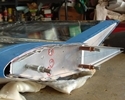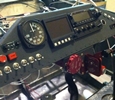


random user submitted photo
Preparing the pilot for first flight
19 posts
• Page 2 of 2 • 1, 2
Re: Preparing the pilot for first flight
builderflyer wrote: was how the last part of your journey home was made in the dark of night. The hair still stands up on the back of my neck thinking about what an electrical failure (or engine failure for that matter) in a new to you experimental aircraft may have meant to the safe completion of the flight home. ...
It's all in the risk assessment and how comfortable one is with the assessed risk. I'm comfortable flying at night in good VFR with a defined horizon. Lots of folks just won't fly at night - period. Yes the risk is higher than day. But that is always so. In the risk assessment for that leg - it was "known ground". Principally over beaches or airports and the previous two legs had been fine. At that point the I didn't think the "risk" was much more than any other night flight in a piston single. I had Vg figured earlier if needed. I'm not claiming to be "right" and YMMV.
--
DMMS - Yes! In my legacy Sonex / Aerovee - I use 60KIAS at a maximum bank of 45 degrees holding altitude. If you let the nose fall through - you can pull it a bit harder - but I have a placard on the panel to remind me. "MMS - 60KIAS @ 45 Degrees"
Graeme JW Smith
-

GraemeSmith - Posts: 939
- Joined: Sat May 18, 2019 8:58 am
- Location: RI
Re: Preparing the pilot for first flight
GraemeSmith wrote:builderflyer wrote: ...
DMMS - Yes! In my legacy Sonex / Aerovee - I use 60KIAS at a maximum bank of 45 degrees holding altitude. If you let the nose fall through - you can pull it a bit harder - but I have a placard on the panel to remind me. "MMS - 60KIAS @ 45 Degrees"
Graeme, What is this DMMS you are referring to? I've never come across it before.
-Brock
Sonex-A (s/n 1013)
R2300, P-tip 54/50
Center Stick
V16, TT22
Sonex-A (s/n 1013)
R2300, P-tip 54/50
Center Stick
V16, TT22
-

BRS - Posts: 432
- Joined: Thu Aug 20, 2020 4:50 pm
Re: Preparing the pilot for first flight
BRS wrote:GraemeSmith wrote:builderflyer wrote: ...
DMMS - Yes! In my legacy Sonex / Aerovee - I use 60KIAS at a maximum bank of 45 degrees holding altitude. If you let the nose fall through - you can pull it a bit harder - but I have a placard on the panel to remind me. "MMS - 60KIAS @ 45 Degrees"
Graeme, What is this DMMS you are referring to? I've never come across it before.
Graeme JW Smith
-

GraemeSmith - Posts: 939
- Joined: Sat May 18, 2019 8:58 am
- Location: RI
Re: Preparing the pilot for first flight
[quote="GraemeSmith"][quote="builderflyer"] was how the last part of your journey home was made in the dark of night. The hair still stands up on the back of my neck thinking about what an electrical failure (or engine failure for that matter)
'
The best advice I ever got for engine failure at night was from my flight instructor who said, 'if the engine fails, glide to 50' AGL and turn the landing light on. If you don't like what you see, turn it off'....
'
The best advice I ever got for engine failure at night was from my flight instructor who said, 'if the engine fails, glide to 50' AGL and turn the landing light on. If you don't like what you see, turn it off'....
Murray Parr
WXB0015
Rotax 912ULS
MGL Explorer Lite
First flight May 6/23
RV9 builder (Sold)
WXB0015
Rotax 912ULS
MGL Explorer Lite
First flight May 6/23
RV9 builder (Sold)
- Murray Parr
- Posts: 251
- Joined: Fri Nov 18, 2016 6:50 pm
Re: Preparing the pilot for first flight
I already had my tailwheel endorsement and about 130 hours of TW time - but, was able to get some transition training in a Sonex/Jab3300 as well as some RV-6 time prior to first flight in my jab/Waiex after completing construction. Both were highly helpful - the Sonex time being the best (sight perspective, pattern speeds, height above runway for flare)- but I also consider an RV-6 or RV-7 a viable alternative - it generally has "similar" sight perspective and power/weight ratio although wing loading isn't quite as close.
Lorin Miller
10+ years in the Jab3300 Waiex
Lorin Miller
10+ years in the Jab3300 Waiex
- ldmill
- Posts: 90
- Joined: Mon Nov 21, 2011 2:30 am
Re: Preparing the pilot for first flight
GraemeSmith wrote:
I lied, I've obviously seen DMMS as I saw that video, what seems like, a very long time ago. Thanks for the reminder it was a good watch the second time around.
-Brock
Sonex-A (s/n 1013)
R2300, P-tip 54/50
Center Stick
V16, TT22
Sonex-A (s/n 1013)
R2300, P-tip 54/50
Center Stick
V16, TT22
-

BRS - Posts: 432
- Joined: Thu Aug 20, 2020 4:50 pm
Re: Preparing the pilot for first flight
Flying and ground movement (taxi) are all pretty straight forward and the solid couple tailwheel will get you comfortable quickly and possibly complacent because you don’t have to toe punch the pedals like other tw planes. Landing was what i had trouble with. I either carrier landed or had the tw about 6” off the ground causing me to porpoise. What helped me was to sit in the plane and line up the horizon with a point where the windscreen touches the dash and put a white dot. Now all i do is come in and flair as low as possible and keep the dot on the horizon and it floats down to a 3pt landing. Took about 50+ hrs to figure it out though. Stay at 60 + and you should be fine and don’t over bank base to final.
Mark
Mark
Mark Whiddon
T25 Aero Estates
Sonex N889AP
jabiru 3300 solid lifter
T25 Aero Estates
Sonex N889AP
jabiru 3300 solid lifter
- tx_swordguy
- Posts: 184
- Joined: Wed Dec 06, 2017 10:11 pm
Re: Preparing the pilot for first flight
Murray Parr wrote:The best advice I ever got for engine failure at night was from my flight instructor who said, 'if the engine fails, glide to 50' AGL and turn the landing light on. If you don't like what you see, turn it off'....
That's what we always tell our helicopter students. "if you have to do an autorotation at night. Get your speed nailed, then turn on the landing light...." The rest is the same as your instructor's advice.
Joe Norris
Sonex N208GD (S/N 450)
Sonerai II N13NN (S/N 1206)
Fortes Fortuna Adiuvat
Sonex N208GD (S/N 450)
Sonerai II N13NN (S/N 1206)
Fortes Fortuna Adiuvat
-

Sonerai13 - Posts: 415
- Joined: Tue Nov 05, 2013 5:36 pm
- Location: Oshkosh, WI
Re: Preparing the pilot for first flight
Sonerai13 wrote:Murray Parr wrote:The best advice I ever got for engine failure at night was from my flight instructor who said, 'if the engine fails, glide to 50' AGL and turn the landing light on. If you don't like what you see, turn it off'....
That's what we always tell our helicopter students. "if you have to do an autorotation at night. Get your speed nailed, then turn on the landing light...." The rest is the same as your instructor's advice.
I was also taught this during helicopter training. Joking aside, probably the key point is to not panic!
Bryan Cotton
Poplar Grove, IL C77
Waiex 191 N191YX
Taildragger, Aerovee, acro ailerons
dual sticks with sport trainer controls
Prebuilt spars and machined angle kit
Year 2 flying and approaching 200 hours December 23
Poplar Grove, IL C77
Waiex 191 N191YX
Taildragger, Aerovee, acro ailerons
dual sticks with sport trainer controls
Prebuilt spars and machined angle kit
Year 2 flying and approaching 200 hours December 23
-

Bryan Cotton - Posts: 5496
- Joined: Mon Jul 01, 2013 9:54 pm
- Location: C77
19 posts
• Page 2 of 2 • 1, 2
Who is online
Users browsing this forum: Google Adsense [Bot] and 8 guests







